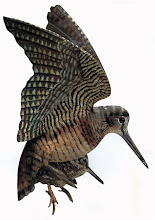Almost at the end of
the 2013 and after ten years of working in this wonderful project, here some
ideas to be rethought.
The history began in 2003. At that time there
were no available PTTs for the Eurasian woodcock.
In 2004 most of the information that was available in internet was analyzed. At
the end of 2004 we knew that MTI was preparing new solar PTTs of 12 grams.
For traditional radio-telemetry tracking, we did know that some woodcocks were
equipped with transmitters of 12 grams
So, at the beginning of January 2005, we contacted MTI.
Here what we said about our woodcocks:
In order to track its
migration (from September-October until the middle of November) we
should have to take in consideration some problems:
a) It is time for its
hunting, so lot of problems to survive.
b) The bird uses brushy
forest to protect itself.
This is why we would prefer to follow it in its
counter migration, from the Spanish state to its breeding areas (maybe up to
the Ural Mountains).
The counter migration has
some advantages:
1) The bird goes right away to its breeding areas.
2) It does not use as much
the brushy forest as it uses in its migration.
3) There is no hunting.
The counter migration period is a short one: the bird
leaves the Spanish state around the middle of March and in a couple of weeks
all, or at least most of the birds are gone.
All the above makes our project easier in the counter
migration than in the migration period.
On March 1st, 2005, we sent MTI an email with the following decision:
(a)
We are planning to follow the counter migration of the Scolopax rusticola, starting next March 2006
(b)
So, we will need (some) PTT-100 12 gram Solar PTTs to be in our hands by
next January, 2006
2. The project goes on…
After A First!
in 2006, we had very interesting experiences.
Here
some key points:
(i)
We were aware of the problem of the interferences in Europe[4].
(ii)
The Charge charge
of the PTTs is the key point, not only against interferences but also
to give better emissions. So, in new projects the PTTs would have to
charge more. The problem of the interferences is really serious, hard
and deep[5].
(iii)
The
woodcock's weight is around 300/350 grams. There
is no possibility, up to now, to track them with Argos/GPS PTTs[6].
(iv)
The problem of the interferences has been overcome with high charge,
as we proposed in our previous experiments[7].
(v)
Last words: Is
it possible to gather even more data? To gather even more accurate
data?
We will keep working, researching, trying to know more about the
migration of the Scolopax
rusticola
and to gather data with more frequency and better accuracy, always
following the advices of MTI[8].
(vi)
Solar
Argos/GPS PTTs:
Up to now, 2011, there is no possibility to track woodcocks with
Argos/GPS PTTs, since the smallest solar Argos/GPS PTT weights 22
grams. In any case, at the prototype level, MTI has produced one of
15 grams. It is very possible the next one to be one of 11/12
grams[9].
(vii)
Last words: Is it possible to gather even more data? To gather even
more accurate data, maybe with the help of a
new Argos/GPS PTT,
small enough to be carried by woodcocks?[10]
L
3. The 2012 Avian & Marine Tracking Conference
Inside the Conference Hall there is
a big mural where the following can be read:
GPS: THE FUTURE
IS HERE
At the end of my
talk,
I said:
“We need a PTT with GPS, to be inside that
future.”
4. 2013: email to MTI
In 2013 we have had two main events related
to the project SRWF.
One is related to the woodcock Ortegal.
Ortegal was hunted on 14.11.2013. The hunters gave us the PTT.
The PTT was without emitting since 26.10.2013, so we checked that PTT to know if
it worked or not.
After that checking, I wrote an email to MTI (23/11/2013):
“In spite of the weather the data
are pretty good…
So, in my opinion, and as
hypothesis, the poor data given by the different woodcocks in their coming back
towards their release points is due to the behavior of these birds, hiding in
the forest to protect themselves and with no very good opportunities for the
PTT to charge well.
No problem with the PTTs and/or with
the Satellites (Argos).
We need a new
technology: a kind of Argos/GPS PTT of 10/12 g.”
